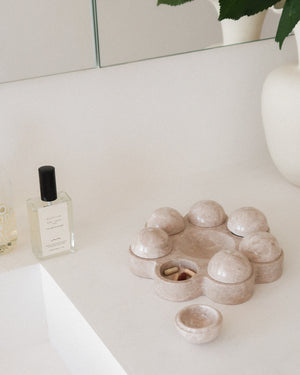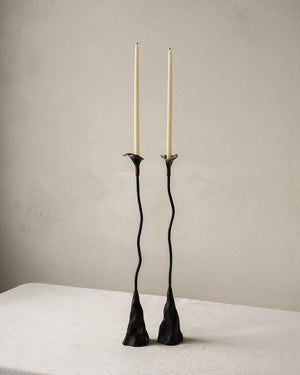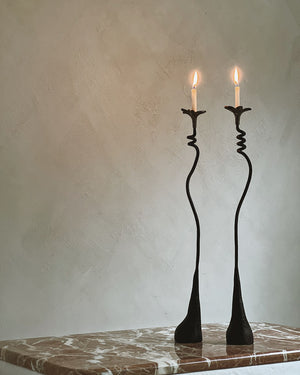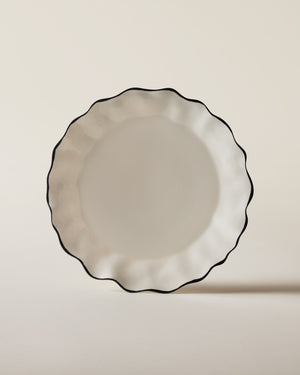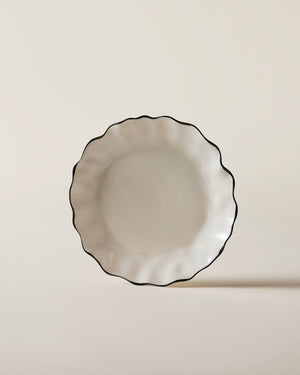Neoclassical Design 101
There's something about Neoclassical design that feels especially relevant right now. Maybe it's the craving for spaces that feel intentional, grounded, and collected. Or perhaps it's just that we're collectively moving away from trends that feel fast and fleeting, and gravitating instead toward interiors that are timeless, elegant, and full of quiet confidence.
 Designed by Paolo Moschino and Philip Vergeylen. Photo by James Mollison
Designed by Paolo Moschino and Philip Vergeylen. Photo by James Mollison
We are finding ourselves drawn to the balance and symmetry of Neoclassical interiors—the way they feel elevated without being showy, artistic without being overly ornate. There's a certain stillness to this style that feels like a breath of fresh air. Whether it's a sculptural urn tucked into a bookshelf or a marble pedestal anchoring a room, Neoclassical design makes the historical feel personal again.
 Antique French Candlestick Holders |
 Candelabra by Gianfranco Briceño |
In this journal entry, we're diving into what makes Neoclassical design so enduring, why it's inspiring us right now, and how you can bring its refined sensibility into your own space—without feeling like you live in a museum.

The Home of Nicolas Bos
 The Samara Vessel |
 The El Deseo Side Table |
Rooted in the grandeur of ancient Greece and Rome, Neoclassical design first emerged in the mid-18th century as a response to the excess and ornamentation of the Rococo period. Artists, architects, and designers began looking back to classical antiquity for inspiration, valuing restraint, harmony, and proportion over extravagance.
It was a return to form—quite literally—with columns, pediments, and classical motifs reappearing across interiors and architecture. The style found its footing in Europe, particularly Britain and France, and later became a hallmark of American Federal-style homes.

Designed by Stephen Sills
Today, we're seeing a resurgence of Neoclassical influences in architecture and interior spaces, but with a modern touch. The silhouettes remain crisp, the symmetry strong, but there's a softness, too—muted palettes, textural materials, and a considered mix of old and new.
 The Pomponette Candlestick Holders |
 The Petite Pomona Bowl |
Characteristics of Neoclassical Interior Design
At its core, Neoclassical design is characterized by:
- Elegant and Historical Furnishing and Accessories: Furniture pieces are refined and understated, often featuring straight lines, fluting, and gentle curves. Expect subtle nods to the art of Greece and Rome.
- Symmetry and Proportion: Spaces are arranged with balanced layouts, often featuring matching furnishings and architectural elements to create a harmonious environment.
- Muted Color Palette: Walls and furnishings typically showcase neutral tones such as whites, creams, and grays, occasionally accented by subdued hues like soft blues or greens.
- Classical Motifs: Decorative elements often include Greek and Roman-inspired details like columns, friezes, and medallions, adding a touch of antiquity to the space.
- Luxurious Materials: The use of high-quality materials such as marble, brass, and rich woods enhances the sense of sophistication and grandeur.
 Designed by Patricia McClean Interiors
Designed by Patricia McClean Interiors
 The Achilles Set |
 Ram's Head Candlestick Holder |
Designers and collectors alike embrace the style for its ability to create spaces that feel collected, layered, and meaningful. The results are timeless, with a quiet sense of drama. A single Neoclassical element—a bust, a fluted column, a curved leg —can bring a sense of order and romance to an otherwise contemporary space. It doesn't shout, but it knows how to make a statement.
